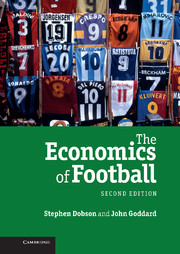Book contents
- Frontmatter
- Contents
- Preface
- Acknowledgements
- List of figures
- List of tables
- 1 Introduction
- 2 The economic theory of professional sports leagues
- 3 Competitive balance, uncertainty of outcome and home-field advantage
- 4 Forecasting models for football match results
- 5 Game theory and football games
- 6 English professional football: historical development and commercial structure
- 7 Determinants of professional footballers' salaries
- 8 Professional footballers: employment patterns and racial discrimination
- 9 The football manager
- 10 The football referee
- 11 Spectator demand for football
- 12 Gambling on football
- 13 Football around the world: France, Germany, Brazil, Japan and China
- 14 The economics of the World Cup
- References
- Index
10 - The football referee
Published online by Cambridge University Press: 05 June 2012
- Frontmatter
- Contents
- Preface
- Acknowledgements
- List of figures
- List of tables
- 1 Introduction
- 2 The economic theory of professional sports leagues
- 3 Competitive balance, uncertainty of outcome and home-field advantage
- 4 Forecasting models for football match results
- 5 Game theory and football games
- 6 English professional football: historical development and commercial structure
- 7 Determinants of professional footballers' salaries
- 8 Professional footballers: employment patterns and racial discrimination
- 9 The football manager
- 10 The football referee
- 11 Spectator demand for football
- 12 Gambling on football
- 13 Football around the world: France, Germany, Brazil, Japan and China
- 14 The economics of the World Cup
- References
- Index
Summary
Introduction
Football referees are much maligned individuals. They are routinely criticised by managers, players, journalists and spectators for being incompetent, inconsistent and biased. The decisions referees make (often taken in a split-second) can be crucial for a team's prospects of achieving success, while the financial implications of success or failure for individual clubs can be enormous. This helps to explain why the actions of referees today are more intensely scrutinised than ever before. Football authorities are under pressure to take steps to ensure that refereeing decisions are fair, consistent and accurate. The intense criticism of referees in recent times has been reflected in a number of academic papers investigating sources of bias and inconsistency in referee decision-making in various sports and countries.
In this chapter, Section 10.1 describes the historical evolution of the football referee, and the referee's role in modern-day football. Repeated calls for the use of video or other forms of technology to assist or adjudicate in resolving contested or controversial incidents, and for refereeing duties to be shared between more officials, have so far been resisted by football's governing bodies. Accordingly, the referee remains the ultimate authority on the field of play, and exercises considerable discretion when officiating games. For example, in the case of foul play the referee has the discretion to decide whether the foul merits a caution, in the form of a yellow or red card. The discretion given to referees may encourage favouritism in their decision-making.
- Type
- Chapter
- Information
- The Economics of Football , pp. 295 - 320Publisher: Cambridge University PressPrint publication year: 2011



